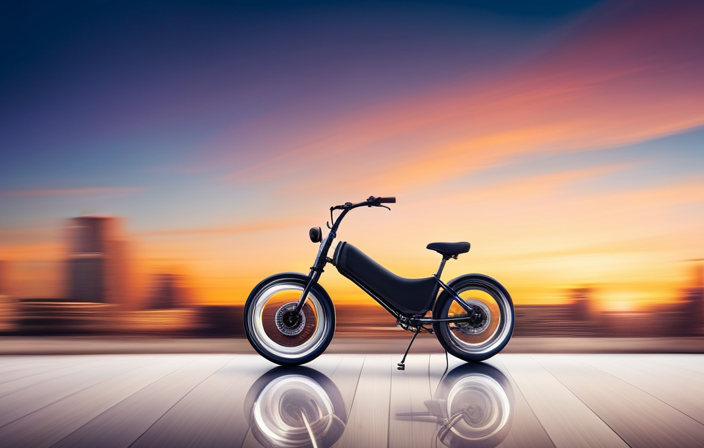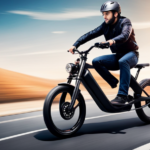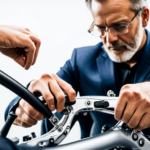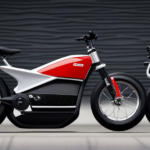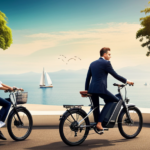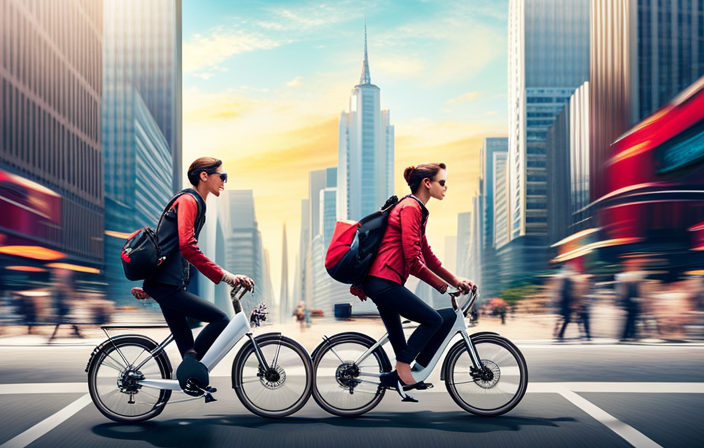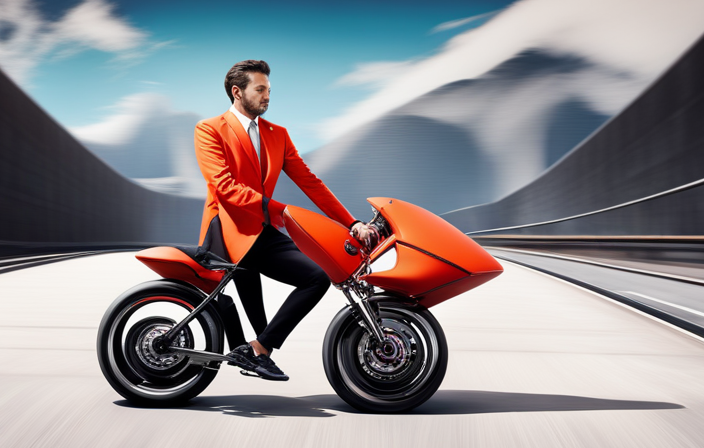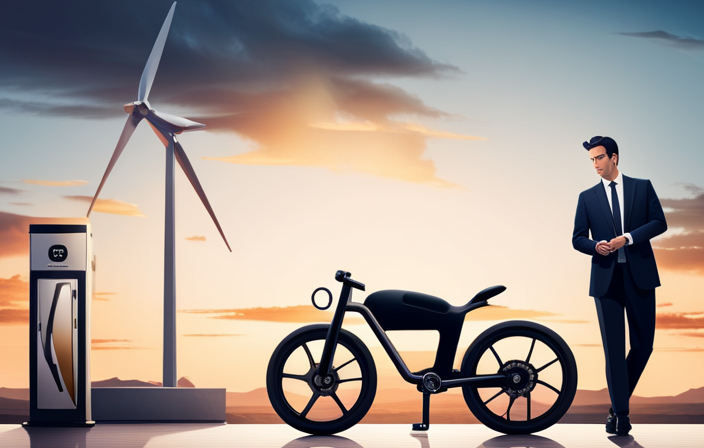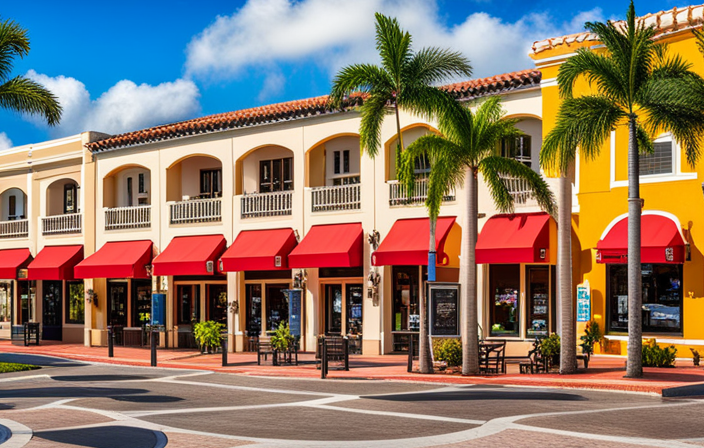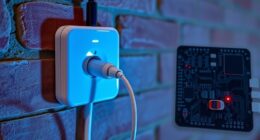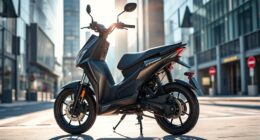Riding an electric bike can be a thrilling experience, but what if you could take it to the next level? Imagine effortlessly cruising at a speed of 35 mph, feeling the wind in your hair and the excitement in your veins.
In this article, we will guide you through the process of building your very own electric bike capable of reaching such exhilarating speeds. From selecting the right components to fine-tuning the bike, we will delve into the technical aspects of this project, giving you the knowledge and skills to create your own high-speed electric bike.
Key Takeaways
- Electric bike batteries: lithium-ion, lead-acid, nickel-metal hydride
- Types of electric bike motors: hub motors, mid-drive motors
- Motor power determines speed and acceleration
- Battery capacity determines range
Understanding the Basics of Electric Bikes
You’ll need to understand the basics of electric bikes before you can start building an electric bike that can reach speeds of 35 mph.
To begin, let’s talk about electric bike batteries. These are the heart of the electric bike and provide the necessary power to the motor. There are several types of electric bike batteries available, including lithium-ion, lead-acid, and nickel-metal hydride. Each type has its own advantages and disadvantages, so it’s important to choose the one that suits your needs best.
Moving on to the types of electric bike motors, there are two main options: hub motors and mid-drive motors. Hub motors are located in the wheel hub, providing direct power to the wheel, while mid-drive motors are positioned near the pedals, offering better balance and efficiency.
Understanding these components will lay the foundation for building a high-speed electric bike. Now, let’s move on to the next section about choosing the right bike frame.
Choosing the Right Bike Frame
First, pick a suitable bike frame that meets your speed requirements. When upgrading components for an electric bike that can reach 35 mph, the frame material selection is crucial. Look for a frame that is sturdy and lightweight, such as aluminum or carbon fiber, to ensure stability and maneuverability at high speeds.
Aluminum frames are commonly used for their strength and affordability, while carbon fiber frames offer a higher level of performance but come at a higher price point. Consider the geometry of the frame as well, as this can affect the bike’s handling and aerodynamics. By choosing the right bike frame, you can lay a solid foundation for building an electric bike that can reach 35 mph.
Now, let’s move on to selecting the motor and battery for your high-speed electric bike.
Selecting the Motor and Battery
When choosing the motor and battery for your high-speed e-bike, it’s important to consider factors such as motor power and battery capacity. The motor power determines the speed and acceleration of your electric bike. Higher power motors, typically measured in watts, will provide more torque and allow you to reach higher speeds. The battery capacity, measured in watt-hours (Wh), determines the range of your e-bike. A higher capacity battery will allow you to travel longer distances before needing to recharge.
To help you understand the relationship between motor power and battery capacity, here is a table that showcases different combinations:
| Motor Power (watts) | Battery Capacity (Wh) |
|---|---|
| 500 | 500 |
| 750 | 750 |
| 1000 | 1000 |
| 1500 | 1500 |
By selecting the right motor power and battery capacity, you can ensure that your electric bike can reach the desired speed of 35 mph while providing sufficient range. Now, let’s move on to the next section and discuss installing the motor and battery system.
Installing the Motor and Battery System
To successfully install the motor and battery system, it’s crucial to follow the proper steps and ensure all components are properly connected. Here are the key steps to guide you through the process:
-
Begin by positioning the motor in the designated area on the bike frame, aligning it with the chain and rear wheel.
-
Secure the motor using the appropriate mounting brackets and bolts, ensuring it is tightly fastened to the frame.
-
Connect the motor to the bike’s drivetrain, ensuring the chain is properly aligned and tensioned.
-
Next, carefully connect the battery to the motor controller, making sure to match the positive and negative terminals correctly.
-
Finally, secure the battery to the bike frame using the provided mounting brackets, ensuring it is firmly fixed in place.
With the motor and battery system correctly installed, you can now move on to the next section about wiring and electrical connections.
Wiring and Electrical Connections
Now you can begin wiring and making electrical connections for your motor and battery system. Start by gathering all the necessary electrical components, such as wires, connectors, and switches.
Carefully follow the wiring diagram provided by the manufacturer to ensure proper connection of each component. Pay close attention to the battery management system, as it is crucial for the safety and longevity of your electric bike.
Double-check all connections to ensure they are secure and free of any loose wires. Once the wiring is complete, test each connection to verify that the electrical system is functioning correctly.
Now that you have successfully wired your motor and battery system, you can move on to the next step of adding a controller for speed control, which will allow you to regulate the speed of your electric bike effortlessly.
Adding a Controller for Speed Control
Next, you’ll need to attach a controller to regulate the speed of your electric bike. The speed controller installation is a crucial step in achieving the desired speed of 35 mph. Follow these steps to ensure a successful installation:
-
Choose a suitable location on your bike to mount the controller. Ensure it is easily accessible and protected from water and other elements.
-
Connect the wires from the controller to the battery, motor, and throttle according to the provided wiring diagram. Double-check all connections to avoid any electrical issues.
-
Adjust the speed settings on the controller. This can usually be done through a digital display or by using the provided software. Follow the manufacturer’s instructions for precise adjustments.
-
Test the speed control by gradually increasing the throttle. Make sure the bike accelerates smoothly and reaches the desired speed.
After completing the speed controller installation and adjusting the speed settings, you can now move on to upgrading the brakes and suspension for enhanced performance and safety.
Upgrading the Brakes and Suspension
For an improved riding experience and enhanced safety, consider upgrading your brakes and suspension. Upgrading the brakes and suspension is crucial when increasing the speed of your electric bike. As you push your bike to reach 35 mph, having reliable and responsive brakes becomes essential for your safety and the safety of others. Upgrading to high-performance disc brakes will provide the stopping power needed to handle higher speeds, giving you peace of mind and confidence in your ability to control your bike. Additionally, upgrading the suspension system will improve stability and handling, allowing for a smoother ride even at higher speeds. By ensuring your brakes and suspension are up to par, you can fully enjoy the exhilaration of riding your electric bike at 35 mph. In the next section, we will discuss the installation of a throttle or pedal assist system, which will further enhance your riding experience.
Installing a Throttle or Pedal Assist System
To further enhance your riding experience, you can install a throttle or pedal assist system. These systems provide different ways to control the speed of your electric bike. Here are the advantages and disadvantages of each:
-
Throttle:
-
Advantages:
-
Instant speed control with a simple twist of the throttle.
-
Allows for quick acceleration and easy maneuverability.
-
Disadvantages:
-
May require more effort to comply with local regulations.
-
Can lead to higher energy consumption, reducing the overall range of your bike.
-
Pedal Assist:
-
Advantages:
-
Provides a more natural riding experience, as the motor assists your pedaling.
-
Enhances your physical fitness while still enjoying the benefits of an electric bike.
-
Disadvantages:
-
Requires continuous pedaling to maintain assistance.
-
May not provide the same level of control as a throttle system in certain situations.
To install a throttle system, follow these steps:
- Locate the appropriate wires and connectors.
- Connect the throttle to the controller.
- Secure the throttle in a comfortable position on the handlebars.
- Test the throttle to ensure proper functionality.
Now that you have installed your throttle or pedal assist system, let’s move on to choosing the right gearing and drivetrain.
Choosing the Right Gearing and Drivetrain
Now that you have installed your throttle or pedal assist system, it’s time to consider the right gearing and drivetrain for your electric bike.
Choosing the right gearing is crucial to ensure optimal performance and efficiency. You need to find the optimal gear ratios that will allow you to achieve your desired top speed of 35 mph while still maintaining good acceleration and torque. This may require some experimentation and fine-tuning, but it’s worth the effort to find the perfect balance.
When it comes to the drivetrain, you have two main options: belt drive or chain drive. Belt drive systems are known for their smooth and quiet operation, requiring less maintenance compared to chain drive systems. However, chain drive systems are generally more affordable and offer a wider range of gear ratios. Consider your priorities and budget when making this decision.
Now that you have chosen the right gearing and drivetrain for your electric bike, you can move on to customizing the bike’s aesthetics without compromising its performance.
Customizing the Bike’s Aesthetics
Once you have selected the ideal gearing and drivetrain for your electric bike, it’s time to personalize its aesthetics to truly make it your own.
Customizing the bike’s color is a great way to showcase your style and stand out on the road. Whether you prefer a vibrant and eye-catching hue or a sleek and understated design, there are various options to choose from.
Additionally, customizing the bike’s accessories can further enhance its appearance and functionality. Consider adding a customized saddle, handlebars, or even a unique headlight to make your electric bike truly one-of-a-kind.
By customizing both the color and accessories of your bike, you can create a personalized and visually appealing ride that reflects your individuality and taste.
Now, let’s transition into the subsequent section about ensuring safety and compliance.
Ensuring Safety and Compliance
Ensuring safety and compliance is crucial when customizing your electric bike. To ensure safety, it is important to adhere to legal requirements set by your local authorities.
Familiarize yourself with the laws and regulations regarding electric bikes, including speed limits, weight restrictions, and lighting requirements. Make sure your bike meets the necessary safety standards, such as having functional brakes, reflectors, and a horn or bell. Additionally, consider wearing appropriate safety gear, such as a helmet and reflective clothing, to increase your visibility on the road.
By ensuring safety and compliance, you can enjoy the benefits of your electric bike while minimizing the risk of accidents or legal issues.
Moving on to testing and fine-tuning the bike, it is essential to evaluate its performance and make necessary adjustments to optimize its speed and overall functionality.
Testing and Fine-Tuning the Bike
To test and fine-tune your bike, you should evaluate its performance and make any necessary adjustments to optimize its speed and overall functionality. Fine tuning techniques are essential to ensure that your electric bike reaches its maximum potential of 35 mph. Performance optimization involves assessing various components of the bike, such as the motor, battery, and controller, to identify any areas that may need improvement. By conducting speed tests, you can measure the bike’s acceleration and top speed, making adjustments as needed. Additionally, fine-tuning the bike’s braking system and suspension can enhance its overall safety and stability at high speeds. Remember to refer to the table below for a summary of fine tuning techniques and their impact on performance optimization.
| Fine Tuning Technique | Impact on Performance Optimization |
|---|---|
| Motor power adjustment | Increase top speed |
| Battery voltage adjustment | Improve acceleration |
| Controller programming | Enhance overall functionality |
| Braking system adjustment | Enhance safety at high speeds |
| Suspension tuning | Improve stability |
By implementing these fine tuning techniques, you can optimize your electric bike’s performance and achieve a maximum speed of 35 mph. In the next section, we will discuss how to maintain and troubleshoot your electric bike without compromising its functionality.
Maintaining and Troubleshooting the Electric Bike
To maintain and troubleshoot your e-bike, you should regularly inspect and clean its components to ensure optimal functionality. Here are some troubleshooting techniques and common maintenance issues to consider:
-
Battery: Check the battery connections and charge level regularly. If the battery is not holding a charge or the range has significantly decreased, it may need replacement.
-
Motor: Inspect the motor for any signs of damage or overheating. Clean the motor regularly to prevent dust and debris from affecting its performance.
-
Brakes: Test the brakes regularly to ensure they are working effectively. Adjust the brake pads and replace them if they are worn out.
-
Tires: Check the tire pressure and tread regularly. Replace any worn-out tires to maintain good traction and prevent accidents.
By following these maintenance practices and troubleshooting techniques, you can keep your electric bike running smoothly.
Now, let’s move on to tips for riding an electric bike at high speeds.
Tips for Riding an Electric Bike at High Speeds
When riding your e-bike at high speeds, it’s important to be aware of your surroundings and maintain control. High speed maneuverability is crucial for a safe and enjoyable ride. To ensure your safety, there are a few safety precautions you should follow when riding at high speeds. Firstly, always wear a helmet to protect your head in case of any accidents. Additionally, make sure to keep a safe distance from other vehicles on the road to avoid collisions. Furthermore, it’s essential to have a firm grip on the handlebars and maintain a proper riding posture to maintain control of the bike. Lastly, regularly inspect your brakes and tires to ensure they are in good condition for high-speed riding. By following these safety precautions, you can have a thrilling and secure experience while riding your electric bike at high speeds.
Now, let’s explore the benefits and limitations of electric bikes.
Exploring the Benefits and Limitations of Electric Bikes
Now that you have learned some tips for riding an electric bike at high speeds, let’s delve into the benefits and limitations of these innovative vehicles.
By exploring the environmental impact and understanding the cost effectiveness, you can make an informed decision about whether an electric bike is the right choice for you.
Electric bikes have gained popularity due to their eco-friendly nature, emitting zero emissions and reducing carbon footprints. Additionally, they offer a cost-effective alternative to traditional transportation methods, with lower maintenance and fuel costs.
However, it is important to note that electric bikes do have some limitations, such as limited range and the need for battery recharging.
By weighing these factors, you can determine if the benefits outweigh the limitations and make a well-informed decision about incorporating an electric bike into your lifestyle.
Frequently Asked Questions
Can I legally ride an electric bike at 35 mph on public roads?
To legally ride an electric bike at 35 mph on public roads, you need to adhere to the electric bike speed limits and meet the legal requirements for such speeds.
Electric bike speed limits vary by jurisdiction, so it is crucial to check the specific regulations in your area.
Additionally, you may need to ensure your electric bike meets certain criteria, such as having a motor wattage below a certain threshold and complying with safety equipment standards.
How much weight can an electric bike that reaches 35 mph carry?
With a weight capacity of up to 300 pounds, electric bikes that reach speeds of 35 mph can handle a substantial amount of cargo.
Imagine a sturdy pack mule, carrying supplies through rugged terrain. Similarly, these bikes can transport groceries, backpacks, or even small furniture effortlessly.
Their cargo capacity, combined with their speed, make them ideal for urban commuting or weekend adventures.
Ride confidently, knowing your electric bike can handle whatever you need to carry.
Are there any specific safety gear requirements for riding at high speeds on an electric bike?
When engaging in high-speed riding on an electric bike, it is imperative to adhere to specific safety gear requirements. To ensure maximum protection, you should wear a DOT-approved helmet, sturdy gloves, and protective eyewear.
Additionally, it is advisable to invest in a well-fitted motorcycle jacket with reinforced padding and abrasion-resistant pants. These safety measures are crucial in minimizing the risk of injury and providing optimal protection during high-speed rides on an electric bike.
Can I use regenerative braking on my electric bike to extend the battery range?
Yes, you can use regenerative braking on your electric bike to extend the battery range. By utilizing regenerative braking, the electric motor acts as a generator, converting the kinetic energy produced during braking into electrical energy.
This energy is then stored back into the battery, effectively increasing the overall range of the bike. The benefits of regenerative braking in electric bikes include improved efficiency, increased battery life, and a more sustainable and eco-friendly mode of transportation.
Are there any limitations to the range of an electric bike that can reach 35 mph?
Riding an electric bike at 35 mph may feel like soaring through the wind, but there are limitations to its range.
The speed comes at a cost, as higher speeds drain the battery faster, reducing the distance you can travel on a single charge.
Additionally, the weight of the bike, terrain, and riding style can affect the range.
It’s crucial to consider these factors when aiming for a 35 mph electric bike to ensure you don’t fall short on range.
Conclusion
Congratulations on successfully mastering the art of building an electric bike that can reach speeds up to 35 mph. Just like a skilled architect, you carefully selected the right bike frame, motor, and battery to create a powerful and efficient machine.
With meticulous wiring and electrical connections, you ensured seamless performance. By testing and fine-tuning, you transformed your creation into a high-speed marvel.
Remember, maintenance and troubleshooting are crucial for its longevity. So gear up and enjoy the exhilarating ride of your electric bike, a true lightning bolt on wheels!

